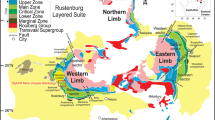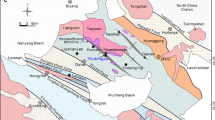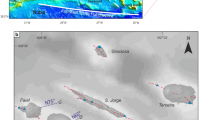Abstract
The results of skarn-forming processes at contacts of the multiphase Southern California Batholith with carbonate rocks accessible to study in quarries in Riverside, California, involve prograde metasomatic transformations of marmorized dolomites and calcareous rocks in contact with granitic melts and contaminated magmas. The processes of contact assimilation are proved to have been controlled by the emplacement of granitic melts overheated relative to subliquidus melts (with the overheated melts prone to approach the composition of granodiorite, syenite, and gabbro) into skarnified marbles. The degree of magma overheating was evaluated based on G.F. Smith’s data on linear melting temperature variations for anhydrous intrusive rocks with various SiO2 concentrations (<750°C for granites and >1100°C for contaminated rocks, ΔT 350°). This corresponds to the thermal regime of the development of mineralogically contrasting hypabyssal skarn aureoles: magnesian at contacts with granite magmas and calcic at contacts with melts of high basicity. The peripheral parts of the aureoles ubiquitously contain preserved zones of forsterite calciphyres and periclase marbles, whereas skarns at mafic intrusions consist of high-temperature silicates of decreasing Mg contents: monticellite, merwinite, melilite, and spurrite. Prograde and retrograde mineralforming processes in the metasomatic rocks and their facies affiliation are analyzed, and the chemical composition of the minerals are examined. The Riverside skarn aureoles are compared with other compositionally contrasting skarn aureoles that developed in contacts with granite magmas and melts of increasing basisity.
Similar content being viewed by others
References
E. S. Larsen and R. C. Schmidt, “A Reconnaissance Idaho Batholith and Comparison with the Southern California Batholith,” Bull. U.S. Geol. Surv., No. 1070-A, (1958).
J. W. Daly, “Paragenesis of the Mineral Assemblage at Crestmore, Riverside County, California,” Am. Mineral. 20(12), 638–659 (1935).
A. O. Woodford, R. A. Crihhtn, and K. B. Garner, “Section Across Commercial Quarry, Crestmore, California,” Am. Mineral. 26(6), 351–381 (1941).
C. W. Burham, “Contact Metamorphism of Magnesian Limestones at Crestmore, California,” Bull. Geol. Soc. Am. 70(7), 879–920 (1959).
F. DeVito and A. Ordway, Jr., “The Jensen Quarry, Riverside County, California,” Mineral. Rec. 15(5), 273–290 (1984).
S. M. Aleksandrov, Geochemistry of Skarnand Ore Formation in Dolomites (VSP, Tokyo-Utrecht, 1996).
S. M. Aleksandrov, “Genesis and Mineralogy of Calc Skarns of the Prograde and Retrograde Metasomatic Stages,” Geokhimiya, No. 3, 281–297 (2002) [Geochem. Int. 40, 244–259 (2002)].
D. S. Korzhinskii, “Outline of Metasomatic Processes,” in Main Problems in the Concepts of Magmatic Ore Deposits (Akad. Nauk SSSR, Moscow, 1955), pp. 335–456 [in Russian].
D. S. Korzhinskii, Theory of Metasomatic Zoning (Nauka, Moscow, 1982) [in Russian].
S. M. Aleksandrov, “Assimilation of Metamorphically and Metasomatically Altered Carbonate Sequences by Granite Magmas,” Geokhimiya, No. 11, 1398–1415 (1992).
S. M. Aleksandrov, “Skarn Formation after Dolomites in the Contacts of Granite Magmas,” Geokhimiya, No. 6, 801–820 (1993).
S. M. Aleksandrov, “Metasomatic Alterations of Carbonate Rocks at Contacts with Ultrabasic Intrusions,” Geokhimiya, No. 8, 1218–1238 (1985).
F. G. Smith, Physical Geochemistry (Addison-Wesley, 1963).
D. L. Graf and J. R. Goldsmith, “Dolomite-Magnesian Calcite Relations at Elevated Temperatures and CO2 Pressures,” Geochim. Cosmochim. Acta 7(1), 109–128 (1955).
I. D. Mak-Gregor, “Aluminous Diopsides in the Tri-Phase Association Di + Fo + Spl,” in Experimental Petrology and Mineralogy (Nedra, Moscow, 1971) [in Russian].
A. A. Collville and P. A. Collville, “Paraspurrite, a New Polymorph of Spurrite from Inyo County, California,” Am. Mineral. 62(9–10), 1003–1005 (1977).
N. V. Belov, Essays on Structural Mineralogy (Nedra, Moscow, 1976) [in Russian].
S. M. Aleksandrov and M. A. Troneva, “Isomorphism in Borates of the Ludwigite-Vonsenite Series from the Magnesian Skarns of North America,” Geokhimiya, No. 2, 172–186 (2000) [Geochem. Int. 38, 144–158 (2000)].
S. M. Aleksandrov and M. A. Troneva, “Composition, Mineral Assemblages, and Genesis of Serendibite-Bearing Magnesian Skarns,” Geokhimiya, No. 7, 722–738 (2006) [Geochem. Int. 44, 665–680 (2006)].
S. M. Aleksandrov, “Borates of the Sakhaite-Harkerite Series at Magnesian Skarn Deposits in the Northeast of Russia: Genesis and Isomorphism,” Geokhimiya, No. 9, 966–989 (2005) [Geochem. Int. 43, 881–903 (2005)].
R. C. Rouse and P. J. Dunn, “A Contribution to the Crystal Chemistry of Ellestadite and the Silicate-Sulfate Apatites,” Am. Mineral. 67(1–2), 90–96 (1982).
A. V. Zharikov, “Conditions of Skarn Formation: Evidence from Experimental Data,” in Endogenous Ore Formation (Nauka, Moscow, 1985), pp. 101–113 [in Russian].
D. S. Korzhinskii, “Granitization as Magmatic Replacement,” Izv. AN SSSR. Ser. Geol., No. 3 (1952).
V. A. Zharikov, “Magmatic Replacement of Carbonate Rocks,” in International Geological Congress. 21st Session. Reports of Russian Geologists. Problem 14: “Granite Gneisses” (AN USSR, Kiev, 1960), pp. 54–67 [in Russian].
G. A. MacDonald, Volcanoes (Prentice-Hall, Englewood Cliffs, 1972), p. 430.
W. T. Schaller, “Monticellite from San Bernardino County, California, and Monticellite Series,” Am. Mineral. 20(12), 815–827 (1935).
R. Joesten, “High-Temperature Contact Metamorphism of Carbonate Rocks in a Shallow Crustal Environment, Christmas Mountains, Big Bend Region, Texas,” Am. Mineral. 61(6–7), 776–781 (1976).
Ph. B. King, “Geology of the Sierra Diablo Region, Texas,” U.S. Geol. Surv. Prof. Paper, No. 480, 185 (1965).
D. S. Barker and F. N. Hodges, “Mineralogy of Intrusions in the Diablo Plateau, Northern Trans-Pecos Magmatic Province, Texas and New Mexico,” Bull. Geol. Soc. Amer. 88(10), 1428–1436 (1977).
D. S. Barker, L. E. Long, G. K. Hoops, and F. N. Hodges, “Petrology and Rb-Sr Isotope Geochemistry of Intrusions in the Diablo Plateau, Northern Trans-Pecos Magmatic Province, Texas and New Mexico,” Bull. Geol. Soc. Amer. 88(10), 1437–1446 (1977).
T. E. Bridge, “Bredigite, Larnite and Dicalcium Silicates from Marble Canyon,” Am. Mineral. 51(11–12), 1766–1770 (1966).
A. K. Temple and E. Wm. Heinrich, “Spurrite from Northern Coahuila, Mexico,” Mineral. Mag. 33(265), 841–852 (1964).
M. A. Bogomolov, “On Calcareous Skarns of Magmatic Stage,” in Outlines of Physicochemical Petrology (Nauka, Moscow, 1970), Vol. 2, pp. 5–14 [in Russian].
S. M. Aleksandrov and M. A. Troneva, “Genesis and Composition of Ludwigite-Vonsenite Borate Series in Magnesian Skarn of Central and East Asia,” Geokhimiya, No. 9, 992–1011 (2004) [Geochem. Int. 42, 870–886 (2004)].
S. T. Badalov, I. M. Golovanov, and B. L. Khozhatelev, “Monticellite Skarns from Middle Asia,” Dokl. Akad. Nauk SSSR 121(5), 897–900 (1958).
S. M. Aleksandrov, V. L. Barsukov, and V. V. Shcherbina, Geochemistry of Endogenous Boron (Nauka, Moscow, 1968) [in Russian].
R. A. Dzhenchuraeva and D. D. Dzhenchuraev, “Skarns and Mineralization of Gavasay,” (Ilim, Frunze, 1973) [in Russian].
S. M. Aleksandrov, “Geochemistry of Boron and Tin at Deposits of the Magnesian-Skarn Association,” (Nauka, Moscow, 1982) [in Russian].
M-L. Pascal, M. Fonteilles, J. Verkaeren, R. Piret, and S. Marincea, “The Melilite-Bearing High-Temperature Skarns of the Apuseni Mountains, Carpathians, Romania,” Can. Mineral., No. 5, 1405–1434 (2001).
V. Ivanova-Panaiotova, “Merwinite from the Settlement Iglika, Elokhovsko,” Rev. Bulg. Geol. Soc. 23(1), 63–65 (1962) [in Bulgarian].
A. A. Konev and V. S. Samoilov, Contact Metamorphism and Metasomatism in the Aureole of the Tazheran Alkaline Intrusion (Nauka, Novosibirsk, 1974) [in Russian].
V. B. Savel’eva, Z. F. Ushchapovskaya, and T. I. Medvedeva, “New Data on Contact Metamorphism in the Ozerskii Massif,” Geol. Geofiz., No. 12, 51–59 (1990).
E. V. Kislov, Ioko-Dovyren Layered Massif (BNTs SO RAN, Ulan-Ude, 1998).
T. Wencel, L. P. Baumgartner, G. E. Brugmann, et al., “Partial Melting and Assimilation of Dolomitic Xenolith by Mafic Magma: the Ioko-Dovyren Intrusion (North Baikal Region, Russia),” J. Petrol. 43(11), 2049–2074 (2002).
F. Zambonini, Mineralogia Vesuviana (Rosenberg Sellier, Torino, 1936).
A. Rittmann, “Die Geologish Bedingte Evolution und Differenciation des Somma Vesuvius Magma,” Z. Vulk 15(1), 8–84 (1933).
F. Barbieri and I. Leone, “Metamorphic Carbonate Ejecta from Vesuvius Plinian Eruptions: Evidence of the Occurrence of Shallow Magma Chamber,” Bull. Volcanol 23(1), 107–120 (1980).
P. Fulignati, P. Marianelli, R. Santacroce, and A. Sbrana, “The Skarn Schell of the 1944 Vesuvius Magma Chamber: Genesis and P-T-X Conditions from Melt and Fluid Inclusion Data,” Eur. J. Mineral 12(5), 1025–1039 (2000).
B. Rama Rao, “A Brief Note on the Melilite-Nepheline-Calciphyres Formed from the Gabbro-Limestone Reactions, Near Nanjangud, Mysore,” Quart. J. Geologic. Min. Metallurg. Soc. India 16(1), 31–42 (1944).
B. Mason, “Larnite, Scawtite, and Hydrogrossular from Tokatoka, New Zealand,” Mineral. Mag. 42(3–4), 379–392 (1957).
P. M. Black, “Rankinite and Kilchoanite from Tokatoka, New Zealand,” Mineral. Mag. 37(288), 517–519 (1969).
M. J. Rubenach and C. Cuff, “The Occurrence of Coarse-Grained Massive Tilleyite in the Redcap Creek Magmatic Skarn, North Queensland,” Mineral. Mag., No. 1, 71–75 (1985).
S. M. Aleksandrov and V. G. Senin, “Genesis, Composition, and Evolution of Sulfide Mineralization in Magnesian Skarns,” Geokhimiya, No. 6, 614–633 (2005) [Geochem. Int. 43, 559–577 (2005)].
S. M. Aleksandrov, “Endogenous Transformations of Kotoite in Calciphyres at Magnesian-Skarn Deposits of Boron,” Geokhimiya, No. 7, 733–752 (2007) [Geochem. Int. 45, 666–684 (2007)].
S. M. Aleksandrov, “Geochemical Features of the Endogenous Hydration of Magnesium Borates,” Geokhimiya, No. 6, 601–618 (2008) [Geochem. Int. 46, 578–594 (2008)].
Author information
Authors and Affiliations
Corresponding author
Additional information
Original Russian Text © S.M. Aleksandrov, 2011, published in Geokhimiya, 2011, Vol. 49, No. 7, pp. 751–766.
Rights and permissions
About this article
Cite this article
Aleksandrov, S.M. Metasomatic transformations of carbonate rocks observable in quarries of Riverside, California, United States. Geochem. Int. 49, 711–725 (2011). https://doi.org/10.1134/S0016702911030025
Received:
Accepted:
Published:
Issue Date:
DOI: https://doi.org/10.1134/S0016702911030025




